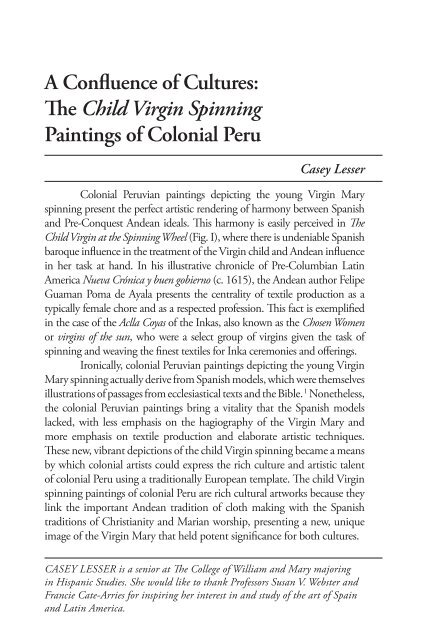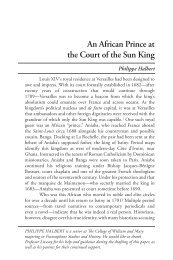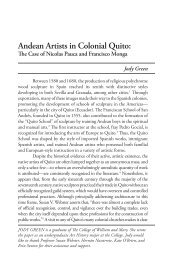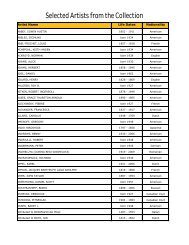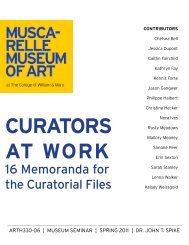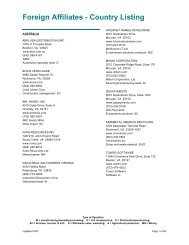A Confluence of Cultures: The Child Virgin Spinning Paintings of ...
A Confluence of Cultures: The Child Virgin Spinning Paintings of ...
A Confluence of Cultures: The Child Virgin Spinning Paintings of ...
Create successful ePaper yourself
Turn your PDF publications into a flip-book with our unique Google optimized e-Paper software.
A <strong>Confluence</strong> <strong>of</strong> <strong>Cultures</strong>:<br />
<strong>The</strong> <strong>Child</strong> <strong>Virgin</strong> <strong>Spinning</strong><br />
<strong>Paintings</strong> <strong>of</strong> Colonial Peru<br />
Casey Lesser<br />
Colonial Peruvian paintings depicting the young <strong>Virgin</strong> Mary<br />
spinning present the perfect artistic rendering <strong>of</strong> harmony between Spanish<br />
and Pre-Conquest Andean ideals. This harmony is easily perceived in <strong>The</strong><br />
<strong>Child</strong> <strong>Virgin</strong> at the <strong>Spinning</strong> Wheel (Fig. I), where there is undeniable Spanish<br />
baroque influence in the treatment <strong>of</strong> the <strong>Virgin</strong> child and Andean influence<br />
in her task at hand. In his illustrative chronicle <strong>of</strong> Pre-Columbian Latin<br />
America Nueva Crónica y buen gobierno (c. 1615), the Andean author Felipe<br />
Guaman Poma de Ayala presents the centrality <strong>of</strong> textile production as a<br />
typically female chore and as a respected pr<strong>of</strong>ession. This fact is exemplified<br />
in the case <strong>of</strong> the Aclla Coyas <strong>of</strong> the Inkas, also known as the Chosen Women<br />
or virgins <strong>of</strong> the sun, who were a select group <strong>of</strong> virgins given the task <strong>of</strong><br />
spinning and weaving the finest textiles for Inka ceremonies and <strong>of</strong>ferings.<br />
Ironically, colonial Peruvian paintings depicting the young <strong>Virgin</strong><br />
Mary spinning actually derive from Spanish models, which were themselves<br />
illustrations <strong>of</strong> passages from ecclesiastical texts and the Bible. 1 Nonetheless,<br />
the colonial Peruvian paintings bring a vitality that the Spanish models<br />
lacked, with less emphasis on the hagiography <strong>of</strong> the <strong>Virgin</strong> Mary and<br />
more emphasis on textile production and elaborate artistic techniques.<br />
<strong>The</strong>se new, vibrant depictions <strong>of</strong> the child <strong>Virgin</strong> spinning became a means<br />
by which colonial artists could express the rich culture and artistic talent<br />
<strong>of</strong> colonial Peru using a traditionally European template. <strong>The</strong> child <strong>Virgin</strong><br />
spinning paintings <strong>of</strong> colonial Peru are rich cultural artworks because they<br />
link the important Andean tradition <strong>of</strong> cloth making with the Spanish<br />
traditions <strong>of</strong> Christianity and Marian worship, presenting a new, unique<br />
image <strong>of</strong> the <strong>Virgin</strong> Mary that held potent significance for both cultures.<br />
CASey LeSSer is a senior at <strong>The</strong> College <strong>of</strong> William and Mary majoring<br />
in Hispanic Studies. She would like to thank Pr<strong>of</strong>essors Susan V. Webster and<br />
Francie Cate-Arries for inspiring her interest in and study <strong>of</strong> the art <strong>of</strong> Spain<br />
and Latin America.
<strong>The</strong> <strong>Child</strong> <strong>Virgin</strong> <strong>Spinning</strong> <strong>Paintings</strong> <strong>of</strong> Colonial Peru<br />
<strong>The</strong> textual sources for the European depictions <strong>of</strong> the child<br />
<strong>Virgin</strong> spinning appear in the Bible and other accounts <strong>of</strong> Christ’s life.<br />
One source in the Bible appears in the Book <strong>of</strong> Proverbs in a discussion<br />
<strong>of</strong> the “virtuous woman.” Here it says that “She seeketh wool, and flax,<br />
and worketh willingly with her hands” 2 and “She layeth her hands to<br />
the spindle, and her hands hold the distaff.” 3 Thus, the Bible dictates<br />
that a “virtuous woman,” must partake in the making <strong>of</strong> cloth, and<br />
this skill <strong>of</strong> cloth making is a virtue. <strong>The</strong>refore, religious texts that<br />
demonstrate the <strong>Virgin</strong>’s participation in cloth making are testaments<br />
to her virtuosity. One such example is found in the Gospel <strong>of</strong> Pseudo-<br />
Matthew, which describes the early life <strong>of</strong> the <strong>Virgin</strong> Mary, specifically<br />
her early years in the Temple, and states:<br />
And she occupied herself constantly with her woolwork,<br />
so that she in her tender years could do all<br />
that old women were not able to do. And this was<br />
the order that she had set for herself: From the<br />
morning to the third hour she remained in prayer;<br />
from the third to the ninth she was occupied with<br />
her weaving; and from the ninth she again applied<br />
herself to prayer. 4<br />
This account illustrates that cloth making was the only activity<br />
that Mary performed other than prayer. <strong>The</strong> fact that Mary, such an<br />
exemplary, holy young woman, took time out <strong>of</strong> her prayer to weave<br />
cloth emphasizes the virtuosity and spiritual value <strong>of</strong> cloth making.<br />
<strong>The</strong> Protevangelium <strong>of</strong> St. James references the <strong>Virgin</strong> weaving cloth:<br />
And there was a council <strong>of</strong> the priests, saying: Let<br />
us make a veil for the temple <strong>of</strong> the Lord. And the<br />
priest said: Call to me the undefiled virgins <strong>of</strong> the<br />
family <strong>of</strong> David. And the <strong>of</strong>ficers went away, and<br />
sought, and found seven virgins. And the priest<br />
remembered the child Mary, that she was <strong>of</strong> the<br />
family <strong>of</strong> David, and undefiled before God. And<br />
the <strong>of</strong>ficers went away and brought her. And they<br />
brought them into the temple <strong>of</strong> the Lord. And the<br />
priest said: Choose for me by lot who shall spin the<br />
51
52 <strong>The</strong> Monitor - Summer 2011<br />
gold, and the white, and the fine linen, and the silk,<br />
and the blue, and the scarlet, and the true purple.<br />
And the true purple and the scarlet fell to the lot<br />
<strong>of</strong> Mary, and she took them, and went away to her<br />
house… And Mary took the scarlet, and span it. 5<br />
Here, the priests <strong>of</strong> the Temple who look for virgins worthy<br />
enough to spin a veil for the temple choose Mary to perform the task.<br />
Thus, Mary’s virtuosity is rewarded with the honor <strong>of</strong> spinning the<br />
temple veil. In the first homily <strong>of</strong> Proclus <strong>of</strong> Constantinople, the <strong>Virgin</strong><br />
is referred to as “the awesome loom <strong>of</strong> the divine economy upon which<br />
the robe <strong>of</strong> union was ineffably woven.” 6 In this instance, the <strong>Virgin</strong><br />
Mary is the metaphorical loom through which mankind and God are<br />
woven together; she is the “weaver” <strong>of</strong> Jesus. Mary is also cited many<br />
times in the Bible as the provider <strong>of</strong> clothing for Jesus, from when “she<br />
brought forth her firstborn son, and wrapped him in swaddling clothes,<br />
and laid him in a manger,” to Christ’s youth, where she is cited as the<br />
maker and mender <strong>of</strong> his clothes. 7 Gail McMurray Gibson explains the<br />
role <strong>of</strong> the seamstress <strong>Virgin</strong> as “literally as well as figuratively, clother<br />
<strong>of</strong> the messiah.” 8 Here, the act <strong>of</strong> giving clothing to Christ is equated<br />
with giving life to Christ, and this powerful message is likely what<br />
drove European artists to portray the <strong>Virgin</strong> making cloth. It is through<br />
these references to Mary as “virtuous woman,” “producer <strong>of</strong> Christ”<br />
and “clother <strong>of</strong> Christ” that the image <strong>of</strong> the <strong>Virgin</strong> spinning appeared<br />
in European art as early as Middle Ages. <strong>The</strong>se images and references<br />
serve as the foundation for the <strong>Virgin</strong> Mary spinning paintings <strong>of</strong><br />
Europe, which evolved into the child <strong>Virgin</strong> Mary spinning paintings<br />
<strong>of</strong> colonial Peru.<br />
In Master Erfurt’s fifteenth-century century German rendition<br />
<strong>of</strong> the <strong>Virgin</strong> spinning, <strong>Virgin</strong> Mary with a Distaff (Fig. II), Mary sits at<br />
a loom, drawing a thread across her body. This same imagery is present<br />
in a contemporary work from Hungary, <strong>Virgin</strong> Mary at the <strong>Spinning</strong><br />
Wheel. <strong>The</strong> thread passes directly through an image <strong>of</strong> the Christ child<br />
located in front <strong>of</strong> the <strong>Virgin</strong>’s womb, indicating her pregnancy. To her<br />
right, the face <strong>of</strong> a man emerges, most likely representing Jesus’ father,<br />
Joseph. Mary is an attractive young woman with long blonde hair, is<br />
dressed in relatively plain clothing, and sits in a simple ecclesiastical
<strong>The</strong> <strong>Child</strong> <strong>Virgin</strong> <strong>Spinning</strong> <strong>Paintings</strong> <strong>of</strong> Colonial Peru<br />
setting. Her eyes look down as all her attention is focused on the task<br />
<strong>of</strong> spinning. Gibson describes the <strong>Virgin</strong> in this scene as holding the<br />
“Thread <strong>of</strong> Life in her hand, clothing the Word in flesh.” 9 <strong>The</strong> “Word”<br />
here undoubtedly refers to the Word <strong>of</strong> God; thus, Mary acts as a<br />
vehicle facilitating Jesus’ mission to spread the Word <strong>of</strong> God. This early<br />
European depiction <strong>of</strong> the <strong>Virgin</strong> spinning connects Mary as mother <strong>of</strong><br />
Jesus to the act <strong>of</strong> creating new life, the life <strong>of</strong> the Christ.<br />
On the Iberian Peninsula, starting with Juan de Roelas,<br />
Spanish portrayals <strong>of</strong> the <strong>Virgin</strong> Mary spinning took a new direction,<br />
representing the <strong>Virgin</strong> not at the time <strong>of</strong> her pregnancy with Jesus, but<br />
in her youth. 10 Images <strong>of</strong> the <strong>Virgin</strong> as a child can also be attributed to<br />
the Protevangelium <strong>of</strong> James, where Mary is said to have learned to sew<br />
from her mother, Anne. 11 In comparison to the two previous paintings,<br />
the composition has changed drastically, and so has the message behind<br />
the <strong>Virgin</strong> and her actions. One can be sure that this child is indeed<br />
the <strong>Virgin</strong> Mary, owing to the inclusion <strong>of</strong> the vase <strong>of</strong> lilies and the<br />
halo <strong>of</strong> cherubim, which are traditional Marian symbols <strong>of</strong> purity. 12<br />
Mary also occupies an interior domestic space, which associates her<br />
with the home and household tasks. Roelas’s young <strong>Virgin</strong> also breaks<br />
from tradition in her fine clothing, signifying the upper-class or, more<br />
prevalent in this case, royalty, because she is a virtuous woman and the<br />
future mother <strong>of</strong> Christ. While in the previous European works the<br />
adult <strong>Virgin</strong> holds a long thread outstretched across her body, in this<br />
work the young <strong>Virgin</strong> child holds a short strand <strong>of</strong> thread in front <strong>of</strong><br />
her and to the side, perhaps because she has yet to become the mother<br />
<strong>of</strong> Christ. She is in the process <strong>of</strong> spinning the strand <strong>of</strong> thread— in<br />
the process <strong>of</strong> living her life out for Christ, preparing for his arrival,<br />
and making him clothes. This <strong>Virgin</strong> also stares straight at the audience<br />
instead <strong>of</strong> at her work, engaging the audience and de-emphasizing the<br />
act <strong>of</strong> spinning.<br />
Pedro Nuñez Villavicencio, another Spaniard, followed Roelas’s<br />
lead, and painted a <strong>Virgin</strong> child, <strong>Virgin</strong> <strong>Spinning</strong> (Fig. III). This work was<br />
created within the context <strong>of</strong> “the height <strong>of</strong> Murillo-style sentimental<br />
piety,” and so the “Sevillian artist Villavicencio separated young<br />
Mary from her old domestic environment and enriched her<br />
appearance, adorning her with the headdress and jewels.” 13 Villavicencio<br />
53
54 <strong>The</strong> Monitor - Summer 2011<br />
followed most <strong>of</strong> Roelas’s conventions, including the specific form <strong>of</strong><br />
the chair in which the child <strong>Virgin</strong> sits However, he exaggerated the<br />
<strong>Virgin</strong> child’s jewelry and gave her a fuller figure, with a facial expression<br />
suggesting wistfulness. <strong>The</strong> <strong>Virgin</strong> child appears to be more interested<br />
in reflection and in looking presentable than in spinning yarn. Unlike<br />
the Erfurt work, that portrays a devout adult <strong>Virgin</strong> devoted to her<br />
spinning, this Villavicencio child <strong>Virgin</strong> appears disengaged from her<br />
work as she gazes toward the viewer. This new child <strong>Virgin</strong> <strong>of</strong> Spain not<br />
only differs from her predecessor in her age, “but also in her demeanor.<br />
As she gazes straight at her audience it is as if she challenges the viewer<br />
to meditate on the meaning <strong>of</strong> her spinning.<br />
In analyzing the young <strong>Virgin</strong> spinning paintings <strong>of</strong> Peru,<br />
it is important also to recognize the Andean origins that may have<br />
informed her development, evident most prominently in her task <strong>of</strong><br />
spinning. In the Pre-Columbian Andes, women were expected to be<br />
skilled at “weaving, spinning, and cooking.” 14 Weaving and spinning<br />
were especially important to Inka society and each Inka woman<br />
was a “cloth-producing ‘specialist.’” 15 Not only did women produce<br />
cloth for themselves and their families, but also for the state. And<br />
so, commoner women between the ages <strong>of</strong> 25 and 50 were primarily<br />
known as makers <strong>of</strong> cloth (129-30). Cloth was at the heart <strong>of</strong> the<br />
economy and politics, and also a form <strong>of</strong> currency, a sign <strong>of</strong> status,<br />
and even a means <strong>of</strong> communication and documentation. 16 Guaman<br />
Poma includes the spindle in his drawings <strong>of</strong> the average Inka female,<br />
at each stage <strong>of</strong> her life. <strong>The</strong> female at age twelve, whose duty is to<br />
herd goats, brings her spindle along with her in this task, suggesting<br />
that the young girl brought her spinning tools with her everywhere,<br />
no matter the circumstances. Guaman Poma’s depiction <strong>of</strong> an Andean<br />
woman at thirty-three years depicts her as a pr<strong>of</strong>essional weaver,<br />
justifying weaving as a respectable pr<strong>of</strong>ession in Inka society. <strong>The</strong><br />
value <strong>of</strong> cloth making is also evident in a colonial painting <strong>of</strong> an Inka<br />
princess from the eighteenth century (Fig. IV). In this painting, the<br />
Inka princess, a member <strong>of</strong> the highest class, is dressed in traditional<br />
Inka attire, including elaborate textiles. She holds in her hand a<br />
spindle signifying the virtuous task <strong>of</strong> spinning, her skill at it, and<br />
how this was even an accepted activity for royal women. She not only
<strong>The</strong> <strong>Child</strong> <strong>Virgin</strong> <strong>Spinning</strong> <strong>Paintings</strong> <strong>of</strong> Colonial Peru<br />
wears fine cloth, but also makes it, justifying spinning and weaving as<br />
more than an activity <strong>of</strong> the lower classes. <strong>The</strong> previously mentioned<br />
Accla Coyas or Aqllakuna, the select group <strong>of</strong> chaste young women<br />
who lived in enclosure, provides another example <strong>The</strong>ir task, among<br />
others, was to produce the finest Inka cloth, known as the cumbi. 17<br />
In one <strong>of</strong> Guaman Poma’s illustrations a crowd <strong>of</strong> these women sit in<br />
what appears to be a courtyard, hard at work with spindles and wool.<br />
<strong>The</strong> prevalence and high value <strong>of</strong> spinning in the Pre-Hispanic Andes<br />
is important in understanding the child <strong>Virgin</strong> spinning paintings,<br />
especially since they were unique to the colonial Andes and spinning<br />
was an activity that was accepted among high and low classes.<br />
Understanding the colonial child <strong>Virgin</strong> spinning paintings<br />
requires an understanding <strong>of</strong> the interaction between Spaniard and<br />
Andeans. Europeans during the colonial period were guilty <strong>of</strong> lumping<br />
all <strong>of</strong> the peoples <strong>of</strong> the Americas into the single category <strong>of</strong> people <strong>of</strong><br />
the New World even though, for example, the Inka peoples <strong>of</strong> the Andes<br />
were completely different than the Aztecs <strong>of</strong> modern-day Mexico. This<br />
European fault is most evident in the allegorical images that emerged<br />
and circulated in the 16 th century depicting America as a voluptuous<br />
woman wearing little clothing but adorned with feathers and weapons<br />
and <strong>of</strong>ten accompanied by an exotic crocodile or armadillo. 18 This<br />
popularized image and the diaries kept by the conquistadores attest<br />
to the fact that Spaniards felt that the Americas needed civilizing, and<br />
the main way to do civilize them was through imposing Christianity.<br />
With this mindset, Francisco Pizarro and his entourage <strong>of</strong> nearly two<br />
hundred men conquered the Andean Inka Empire in 1532, ending a<br />
tradition that had existed for over one hundred years. 19 Following or<br />
accompanying conquistadores, Catholic missionaries were sent to the<br />
colonial Andes to set up centers <strong>of</strong> conversion, and to replace the Andeans’<br />
Inka faith with Christianity. In the process <strong>of</strong> propagating Catholicism,<br />
these missionaries found that the <strong>Virgin</strong> Mary was a “potent ally.” To<br />
the Inka peoples she resembled the goddesses they were accustomed<br />
to worshipping, like Pachamama, “the earth-mother goddess <strong>of</strong> Inca<br />
religion.” 20 <strong>The</strong>refore, the <strong>Virgin</strong> Mary became popularized in colonial<br />
Peruvian religious art not as a figure that allowed Spaniards to impose<br />
Christianity but as a familiar concept to the native Andeans.<br />
55
56 <strong>The</strong> Monitor - Summer 2011<br />
<strong>The</strong> depictions <strong>of</strong> the child <strong>Virgin</strong> spinning in colonial Peruvian<br />
society emerged with a certain template that was adhered to by virtually<br />
all artists (Fig. I). <strong>The</strong> <strong>Virgin</strong> is an adolescent, and she sits in front<br />
<strong>of</strong> a dark background with a floral garland framing her. <strong>The</strong> vase <strong>of</strong><br />
lilies that Roelas included is not present. However, in most cases, the<br />
floral garland frame includes the white lilies and other Marian flowers.<br />
Her body points towards her left, and she is seated in a wooden chair<br />
with a red cushion and gold decoration, holding the distaff under her<br />
left arm, a thread in her left hand with her pinky finger extended,<br />
and the spindle in her right hand. She engages the viewer with round<br />
black eyes and appears distracted from her spinning, perhaps inviting<br />
participation or emulation from the viewer. <strong>The</strong> halo <strong>of</strong> cherubim that<br />
Villavicencio and Roelas represented is not present here. Instead, a starshaped<br />
halo <strong>of</strong> gold rays emanates from the child <strong>Virgin</strong>’s head like<br />
a crown. Draped over her shoulders is a cape-like coverlet with lace<br />
trimming that closes above her chest with a round broche, accompanied<br />
by a matching dress with a corset-like top made <strong>of</strong> fine textiles in red,<br />
gold and silver with floral designs. Her outfit is completed with jewelry,<br />
dangling gold earrings, a set <strong>of</strong> red beaded bracelets on either wrist, red<br />
bows, and a ring on the pinky finger <strong>of</strong> her right hand. A red and gold<br />
headband adorned with a circular decorative broche on the left side<br />
<strong>of</strong> her head pushes back her short, cropped dark hair. <strong>The</strong> majority<br />
<strong>of</strong> these characteristics are found in the Spanish child <strong>Virgin</strong> spinning<br />
models <strong>of</strong> Roelas and Villavicencio, but the Peruvian depictions are<br />
undeniably more elaborate. With the addition <strong>of</strong> a significant amount<br />
<strong>of</strong> gold and decorative elements like the floral garland and dress<br />
adornments, these Peruvian child <strong>Virgin</strong>s appear to be <strong>of</strong> a higher class<br />
than their Spanish counterparts. <strong>The</strong> Peruvian examples also present a<br />
more doll-like figure, as opposed to that <strong>of</strong> a child with a round face,<br />
rosy cheeks, and big eyes. Of my sample <strong>of</strong> seven paintings <strong>of</strong> Peruvian<br />
child <strong>Virgin</strong> spinning paintings, six <strong>of</strong> them possess the majority <strong>of</strong><br />
these characteristics. <strong>The</strong>re is one painting, known as young <strong>Virgin</strong><br />
<strong>Spinning</strong> from the 17 th or 18 th century, that is an exception because<br />
it lacks the floral garland border and the golden halo and instead sits<br />
beneath a halo <strong>of</strong> winged cherubim. This example borrows from the<br />
Roelas and Villavicencio models, but the cherubim here play a more
<strong>The</strong> <strong>Child</strong> <strong>Virgin</strong> <strong>Spinning</strong> <strong>Paintings</strong> <strong>of</strong> Colonial Peru<br />
dominant role: they are solid figures as opposed to their ethereal<br />
predecessors. This child <strong>Virgin</strong> is also different in her dress. She wears<br />
a dark brown cloak and a simpler dress, also reflective <strong>of</strong> Roelas and<br />
Villavicencio. A single ring on her ring finger is a characteristic that is<br />
unique to this example, perhaps alluding to her future marriage. <strong>The</strong><br />
lack <strong>of</strong> decoration and adherence to Spanish models in this painting<br />
suggests it is an early, perhaps even a Spanish import.<br />
Luis Eduardo Wuffarden explains in reference to the Peruvian<br />
child <strong>Virgin</strong> spinning paintings that “all the elements <strong>of</strong> her attire were<br />
already present in her Spanish predecessors, and, in principle, it would<br />
be a mistake to interpret them as the pre-Columbian Andean lliclla<br />
[shawls] or tupu (ornamental brooch) being given a contemporary<br />
recreation.” 21 However, Carol Damian explains, “Mary is dressed in a<br />
combination <strong>of</strong> noble Spanish and Inka costumes. <strong>The</strong> golden patterns<br />
<strong>of</strong> the cloth incorporate both the floral brocades <strong>of</strong> European origin<br />
and the geometric patterns <strong>of</strong> the Inka.” 22 <strong>The</strong>refore, due to the Spanish<br />
models <strong>of</strong> the child <strong>Virgin</strong> spinning, and Andean textile traditions, it<br />
is fair to characterize the dress <strong>of</strong> the Peruvian child <strong>Virgin</strong> paintings<br />
as Spanish but infused with Andean textile traditions. <strong>The</strong> connection<br />
to Andean tradition was surely recognized by indigenous peoples,<br />
and undoubtedly gave these paintings some <strong>of</strong> their power within the<br />
colonial context.<br />
Another example <strong>of</strong> the confluence <strong>of</strong> Spanish and Andean<br />
traditions is present in the child <strong>Virgin</strong>’s hairstyle. Although the child<br />
<strong>Virgin</strong>s in both Spanish and colonial Peruvian paintings have short,<br />
dark cropped hair, Villavicencio appears to have initiated the elaborate<br />
headband trend that the Peruvians continued. <strong>The</strong> curl that the child<br />
<strong>Virgin</strong> wears on her forehead can also be attributed to Villavicencio.<br />
This curl is <strong>of</strong> great interest within colonial Peru, as Damian explains:<br />
To the Spanish observer, the curl is a delightful<br />
addition <strong>of</strong> the native artist. To the native viewer, the<br />
headband and curl represent royal insignia. <strong>The</strong> <strong>Child</strong><br />
Mary is the equivalent <strong>of</strong> the Inka princess (Ñusta)<br />
and the Chosen Women…Also, for the Andean<br />
observer, the golden radiances behind her head are<br />
symbolic <strong>of</strong> Inka royalty’s homage to the sun. 23<br />
57
58 <strong>The</strong> Monitor - Summer 2011<br />
Damian claims then that the colonial Andean people see this child<br />
<strong>Virgin</strong> as the successor to the accla coyas (Fig. II) and the ñustas. <strong>The</strong> “royal<br />
insignia” to which Damian refers is the Inka headdress, the maskapaycha—<br />
“a crimson fringe worn over the forehead, the essential part <strong>of</strong> the royal<br />
headdress.” 24 During the Inka Empire, only the Inka ruler, the Sapa Inka,<br />
wore the maskapaycha, and in colonial Peru, it continued to be a sign <strong>of</strong><br />
nobility. However, controversy centered on who was worthy <strong>of</strong> wearing the<br />
Inka headdress in colonial society. Women were never allowed to wear the<br />
maskapaycha, and in portraits <strong>of</strong> noble Andean women, the maskapaycha<br />
was only present on a table beside the woman, “indicating that [she] derived<br />
[her] status from [her] husband’s right to wear it.” 25 <strong>The</strong>refore, according<br />
to Damian’s interpretation when Andeans viewed the child <strong>Virgin</strong> spinning<br />
with her headband and the curl, they were reminded <strong>of</strong> the red tuft <strong>of</strong> the<br />
maskapaycha. <strong>The</strong> representation <strong>of</strong> an actual maskapaycha on the <strong>Virgin</strong><br />
Mary’s head would not only go against Christianity, but would also subvert<br />
Andean tradition. For this reason, the allusion to the Andean headdress<br />
is subtle, yet it still associates the <strong>Virgin</strong> with Andean nobility and would<br />
likely have received attention and respect from Andean audiences.<br />
Although the colonial image <strong>of</strong> the child <strong>Virgin</strong> serves as a sort<br />
<strong>of</strong> hybrid <strong>of</strong> Spanish and Andean tradition, one cannot ignore her bright,<br />
pale skin. While her skin color functions artistically to seize viewers’<br />
attention and put all focus on the little <strong>Virgin</strong>’s face, it is certainly not the<br />
skin <strong>of</strong> an indigenous Andean person. In some cases, the color used on the<br />
face and hands is so pale it no longer resembles human skin. <strong>The</strong> pattern<br />
among examples <strong>of</strong> this child <strong>Virgin</strong> with bright white skin proves the<br />
intentionality <strong>of</strong> the decision to make her skin light to resemble Spaniards.<br />
<strong>The</strong>refore, since this child <strong>Virgin</strong> was a figure <strong>of</strong> Christian worship that<br />
Andean peoples could relate to, artists were careful to designate that this<br />
figure was more Spanish than indigenous.<br />
Ideological intentions aside, these child <strong>Virgin</strong> spinning paintings<br />
are remarkable testaments to the skill <strong>of</strong> colonial Peruvian artists. <strong>The</strong>re<br />
is an unmistakable close and careful attention to detail in creating these<br />
delicate child <strong>Virgin</strong>s. From the intricate gold lace trimmings, to the<br />
complex headbands, to the elaborate floral garlands, these paintings reflect<br />
painstaking effort and a large time commitment. This careful attention to<br />
the subject emphasizes their importance and suggests that the paintings
<strong>The</strong> <strong>Child</strong> <strong>Virgin</strong> <strong>Spinning</strong> <strong>Paintings</strong> <strong>of</strong> Colonial Peru<br />
were <strong>of</strong> great value within colonial Peru. While there are a few Peruvian<br />
depictions <strong>of</strong> an older <strong>Virgin</strong> Mary, in her early adulthood when she is<br />
engaged in spinning, this large grouping <strong>of</strong> child <strong>Virgin</strong>’s suggests that the<br />
tradition <strong>of</strong> the <strong>Virgin</strong> spinning as a child was more common and popular<br />
in colonial Peru. This can be understood through observing one <strong>of</strong> these<br />
older spinning <strong>Virgin</strong>s, the young <strong>Virgin</strong> Mary Weaving, who undoubtedly<br />
lacks the appeal that the child possesses.<br />
It is also important to recognize that textile production continued<br />
to occupy a place <strong>of</strong> great significance in colonial Peruvian society.<br />
Spaniards were mesmerized with the elaborate and “exotic” textiles <strong>of</strong> the<br />
Andes and demanded the production <strong>of</strong> textiles through tribute to the<br />
state, to the point where they established factories for textile production<br />
known as obrajes. 26 With the introduction <strong>of</strong> the obrajes, men and women<br />
began to work in these factories, using new European upright looms,<br />
while many women remained in domestic space, employing traditional<br />
weaving methods like the distaff and whorl that the child <strong>Virgin</strong> uses. 27<br />
Owing to the continued prevalence <strong>of</strong> spinning, and the Spaniards’ desire<br />
for fine Andean cloth, the child <strong>Virgin</strong> spinning paintings elevated the<br />
task <strong>of</strong> spinning, thereby encouraging women to make cloth through its<br />
association with the affluent <strong>Virgin</strong> and with the accla coyas.<br />
Although this tradition began in Spain, one might wonder why this<br />
child <strong>Virgin</strong> translated so well into Peruvian society? And would this idea <strong>of</strong><br />
the <strong>Virgin</strong> spinning have meant less in colonial Peru if the <strong>Virgin</strong> were an<br />
adult? While it is possible that images <strong>of</strong> the child <strong>Virgin</strong> spinning were the<br />
only models that reached Peru, this does not explain their establishment<br />
and popularization, or their remarkable exclusivity to Peru. One solution<br />
to this conundrum is that the well-established cloth making traditions in<br />
the pre-Hispanic Andes provided the perfect environment to receive this<br />
image <strong>of</strong> the child <strong>Virgin</strong>. For the Andean people, this <strong>Virgin</strong> resembled<br />
and recalled the young Accla Coyas so highly respected by the Inka as well<br />
as the Inka ñustas and coyas with distaffs and spindles. <strong>The</strong>se associations<br />
worked to the favor <strong>of</strong> Spaniards because presenting an image <strong>of</strong> the <strong>Virgin</strong><br />
Mary to which indigenous people could relate facilitated their mission <strong>of</strong><br />
implementing Christianity. By aligning the <strong>Virgin</strong> Mary with one <strong>of</strong> the<br />
greatest Andean pr<strong>of</strong>essions, Spaniards could create an association between<br />
the two, making the <strong>Virgin</strong> Mary a personage that indigenous people could<br />
59
60 <strong>The</strong> Monitor - Summer 2011<br />
understand more easily and would be more likely to accept. Upon learning<br />
the effectiveness and power <strong>of</strong> these paintings, it is likely that Spaniards<br />
would have commissioned more <strong>of</strong> this type <strong>of</strong> painting, disseminating<br />
them across the colony. <strong>The</strong> centrality <strong>of</strong> spinning in Andean culture, the<br />
worship <strong>of</strong> Accla Coyas, and the respect for elite ñustas and coyas to some<br />
extent account for why these paintings thrived in the Andes and not in the<br />
viceroyalty <strong>of</strong> New Spain.<br />
<strong>The</strong> endearing child <strong>Virgin</strong> spinning paintings are an expression<br />
<strong>of</strong> the confluence <strong>of</strong> Spanish and Andean cultures. Although the paintings<br />
derive from Spanish prototypes, their connection to Andean culture is<br />
irrefutable. Whether these paintings were executed by Spanish or by<br />
Andean artists, it seems inevitable that the Spaniards favored the power<br />
these paintings held, and commissioned many copies <strong>of</strong> them. Although<br />
the child <strong>Virgin</strong> does not resemble the indigenous woman <strong>of</strong> colonial<br />
Peru, she is familiar in her activity and dress, and was likely to have been<br />
understood as a figure <strong>of</strong> worship. For women <strong>of</strong> the upper classes, the dolllike,<br />
charming appearance would likely have been adored and associated<br />
with a daughter figure. <strong>The</strong> artistic craftsmanship and skill that the<br />
paintings evince are representative <strong>of</strong> the fine artists <strong>of</strong> colonial Peru and <strong>of</strong><br />
their respect for this subject. Through the fusion <strong>of</strong> Andean and Christian<br />
traditions, the child <strong>Virgin</strong> Mary spinning paintings were masterful artistic<br />
means <strong>of</strong> colonization, presenting Christianity within its new context <strong>of</strong><br />
Colonial Peru in a non-threatening, harmonious way.<br />
Fig. I. Anonymous, <strong>The</strong> <strong>Child</strong> <strong>Virgin</strong> at the <strong>Spinning</strong> Wheel, ca. 1680-<br />
1710, Museo Pedro de Osma, Lima, Peru. MDID.
<strong>The</strong> <strong>Child</strong> <strong>Virgin</strong> <strong>Spinning</strong> <strong>Paintings</strong> <strong>of</strong> Colonial Peru<br />
Fig. II. Master <strong>of</strong> Erfurt, <strong>Virgin</strong> Mary with a Distaff, ca. 15th C.,<br />
Staatliche Museen zu Berlin, Germany. MDID.<br />
Fig. III. Pedro Nuñez Villavicencio, <strong>Virgin</strong> <strong>Spinning</strong>, ca. 17th C.,<br />
Museo del Prado, Spain. MDID.<br />
Fig. IV. Anonymous, An Inca Princess and a Dwarf, ca. 1700-1800,<br />
Colonial Peru. MDID.<br />
61
62 <strong>The</strong> Monitor - Summer 2011<br />
Notes<br />
1 Carol Damian, “<strong>The</strong> <strong>Virgin</strong> <strong>of</strong> the Andes: Inka Queen and Christian Goddess,”<br />
Woman and Art in early Modern Latin America (Leiden: Brill, 2007), 79.<br />
2 <strong>The</strong> Book <strong>of</strong> Proverbs, (New York: Sheldon & Co, 1872), 31:13.<br />
3 Ibid., 31:19.<br />
4 “<strong>The</strong> Gospel <strong>of</strong> Pseudo-Matthew,” <strong>The</strong> Ante-Nicene Fathers: Translations <strong>of</strong><br />
the Writings <strong>of</strong> the Fathers Down to A.d. 325, Eds. Alexander Roberts, James<br />
Donaldson, A.C. Coxe, Allan Menzies, Ernest C. Richardson, and Bernhard Pick<br />
(New York: C. Scribner’s Sons, 1903), 371.<br />
5 “<strong>The</strong> Protevangelium <strong>of</strong> James,” <strong>The</strong> Ante-Nicene Fathers: Translations <strong>of</strong><br />
the Writings <strong>of</strong> the Fathers Down to A.d. 325, eds. Alexander Roberts, James<br />
Donaldson, A.C. Coxe, Allan Menzies, Ernest C. Richardson, and Bernhard Pick<br />
(New York: C. Scribner’s Sons, 1903), 363.<br />
6 Nicholas Constas and Proclus, “Homily I,” Proclus <strong>of</strong> Constantinople and the Cult<br />
<strong>of</strong> the <strong>Virgin</strong> in Late Antiquity: Homilies 1-5, Texts and Translations, Supplements to<br />
Vigiliae Christianae, 66 (Leiden: Brill, 2003), 137.<br />
7 Luke, 2:7.<br />
8 Gail McMurray Gibson, “<strong>The</strong> Thread <strong>of</strong> Life in the Hand <strong>of</strong> the <strong>Virgin</strong>,” equally<br />
in God’s Image: Women in the Middle Ages, Eds. Julia B Holloway, Constance S.<br />
Wright, and Joan Bechtold (New York: P. Lang, 1990), 50.<br />
9 Ibid., 51.<br />
10 Luis Eduardo Wuffarden, “<strong>The</strong> <strong>Child</strong> <strong>Virgin</strong> <strong>Spinning</strong>,” <strong>The</strong> Arts in<br />
Latin America, 1492-1820, eds. Joseph J. Rishel and Suzanne L. Stratton,<br />
(Philadelphia: Philadelphia Museum <strong>of</strong> Art, 2006), 463.<br />
11 Damian, 79.<br />
12 George Ferguson, Signs and Symbols in Christian Art: With Illustrations from<br />
<strong>Paintings</strong> <strong>of</strong> the renaissance (London: Oxford University Press, 1976), 33.<br />
13 Wuffarden, 463.<br />
14 Irene Silverblatt, “Andean Women in the Inca Empire,” Feminist Studies, 4:3 (1978), 42.<br />
15 Cathy L. Costin, “Housewives, Chosen Women, Skilled Men: Cloth Production<br />
and Social Identity in the Late Prehispanic Andes,” Archaeological Papers <strong>of</strong> the<br />
American Anthropological Association, 8:1 (1998), 129.<br />
16 Silverblatt, 42.<br />
17 Costin, 135.<br />
18 Clare Le Corbeiller, “Miss America and Her Sisters: Personifications <strong>of</strong> the Four<br />
Parts <strong>of</strong> the World,” Metropolitan Museum <strong>of</strong> Art Bulletin, 19:8 (1961), 210.<br />
19 Damian, 70.<br />
20 Duncan, 32.<br />
21 Wuffarden, 463.<br />
22 Damian, 88.<br />
23 Ibid., 89.<br />
24 Marie Timberlake, “<strong>The</strong> Painted Colonial Image: Jesuit and Andean Fabrication<br />
<strong>of</strong> History in Matrimonio de García de Loyola con Ñusta Beatriz,” Journal <strong>of</strong><br />
Medieval and early Modern Studies, 29:3 (1999), 573.<br />
25 Ibid., 580-581.<br />
26 Karen B. Graubart, “Weaving and the Construction <strong>of</strong> a Gender Division <strong>of</strong><br />
Labor in Early Colonial Peru,” American Indian Quarterly, 24:4 (2000), 554.<br />
27 Ibid., 555.


